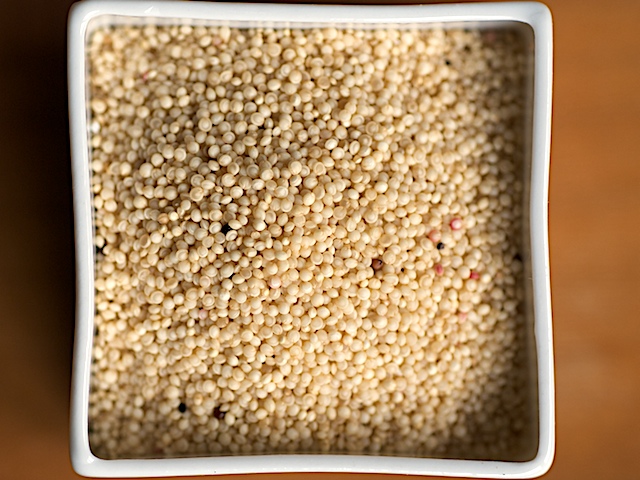
amaranth, l
(article, Carrie Floyd)
[%adInjectionSettings noInject=true][%pageBreakSettings nobreak=true]
[[block(sidebar).
h1.The rice glossary
Also, check out Pat Tanumihardja's fabulous [/articles/features/ricetypesglossary "guide to rice."]
]]
Most people know brown rice when they see it, but what about all the other grains? It's one thing to rattle them off, but it's an entirely different matter to know their various nutritional profiles and how to cook them. Then there's the confusion of defining or classifying grains, as some grains that we call grains are not. True grains belong to the cereal grass family; for this glossary, however, I include edible seeds that share the nutritional properties of whole grains (quinoa, buckwheat, wild rice).
[%image grains float=right width=300 caption="Which grain is which?"] The bulk bins can be bewildering; even when you're familiar with a particular grain, it's mind-boggling to make sense of all the names it may go by. Groats, grits, steel-cut, rolled, puffed, pearled, cracked, flakes, and flour are the most common references, and all describe how the grain has been processed.
For example, groats are grains that have had their hard, inedible hulls removed but still retain their nutritious parts (germ, bran, endosperm).
How the grain has been cut or milled affects both texture (hence taste) and cooking time. Parboiled and cracked wheat, for example, is bulgur, which takes only a few minutes to prepare; on the other hand, wheat berries (the grain in its least-processed form) may take up to an hour to cook.
When shopping for grains, you won't be able to tell by sight whether or not the grains are de-germinated or pearled, so be sure to read the labels. ("De-germinated" means the germ has been removed, and "pearled" refers to a polishing process that removes either part or all of the bran and germ.)
[[block(sidebar).
h1.[/mix/challenge/wholegrainchallenge "The Whole-Grain Challenge" newpage=true]
Carrie Floyd is trying to eat whole grains at every meal for the month of June. [/mix/challenge/wholegrainchallenge#joinnow "Join her!" newpage=true]
]]
By no means is this glossary comprehensive — I barely scratch the surface of rice, and I know of at least a couple of omissions (Job's Tears, rye berries). Because any grain can be milled into flour, and most flours look similar, flours are not included here.
For more information on grains — nutrition profiles, cooking tips, recipes — check out Lorna Sass's book Whole Grains Every Day, Every Way, the Whole Grains Council, and Bob's Red Mill. In the meantime, dive into the grain glossary and let us know if there's a grain you think should be included; this glossary — like the pursuit of eating more whole grains — is a work in progress.
[[block(clear).
[%image amaranth width=300 float=right caption="Amaranth"]
Amaranth
Like quinoa, amaranth is considered a pseudocereal (technically not a grain). Amaranth is gluten-free, high in protein, and contains lysine (making it a complete protein). Amaranth grains can be cooked whole in a pot, rice cooker, or pressure cooker for a breakfast porridge or savory "polenta." Bake cookies or breads with amaranth flour (purchased in bulk or made by grinding the seeds in a spice grinder) combined with a gluten flour.
]]
[[block(clear).
[%image barley width=300 float=right caption="Barley"]
Barley
Barley has an especially tough hull, which when stripped removes some of the bran. There are hull-less varieties, most commonly found in natural-food stores and by mail order. Scotch barley and barley groats retain more of their bran than pearled barley. Barley contains beta-glucan, a soluble fiber attributed to lowering cholesterol, and protein comparable to wheat; it is not gluten-free. Barley is a versatile grain, good in soups, risotto, and grain salads.
]]
[[block(clear).
[%image "buckwheat berries" width=300 float=right caption="Buckwheat berries"]
Buckwheat berries
The name buckwheat is a misnomer, as this grain is neither a wheat nor a buck; buckwheat seeds (or berries) come from a flowering plant in the rhubarb family. Kasha (or kashi) are toasted buckwheat groats (grain kernels that have their tough outer hull removed), most commonly cooked into hot cereal. Buckwheat flour makes tasty pancakes, blinis, and bread; it is the primary ingredient in soba noodles. Gluten-free.
]]
[[block(clear).
[%image "cracked wheat" width=300 float=right caption="Cracked wheat"]
Cracked wheat (Bulgur)
Cracked wheat and bulgur are one and the same: wheat kernels that have been precooked, dried, and cut ("cracked"). This processing is what makes bulgur such a convenience food when it comes to preparing whole grains; it takes minimal time (boiling or soaking) to make it tender. High in fiber, bulgur is not gluten-free. It makes great salads, pilafs, and side dishes; substitute bulgur for rice if you're short on time, as an accompaniment to stir-fries, curries, or stews.
]]
[[block(clear).
[%image farro width=300 float=right caption="Farro"]
Farro
Farro by another name would be wheat; it's an ancient Italian strain called emmer. Choose semi-perlato (semi-pearled) over perlato (pearled), as it has more bran intact. Farro is easily confused with spelt berries; some cooks use them interchangeably. Farro is easy to cook: add it to a pot of boiling water, cook until tender (20 to 30 minutes), then drain. Add cooked farro to sautéed leeks for a simple side dish, or turn it into a salad.
]]
[[block(clear).
[%image "kamut2" width=300 float=right caption="Kamut"]
Kamut
Kamut is the only grain I know of with a trademark, and because of the trademark it's always organic. It's an ancient, or heirloom, wheat grown in Montana, high in protein and vitamin E. Some describe it as buttery; I think it's rather sweet. As grits, it makes a tasty hot cereal. You'll find it in every form you find wheat: berries, cracked, rolled, flakes, puffed, and ground into flour.
]]
[[block(clear).
[%image "long grain brown" width=300 float=right caption="Long-grain brown rice"]
Long-grain brown rice
Brown rice is rice with the germ and bran intact, making it rich in fiber, minerals, and vitamins. (White rice is brown rice that has been polished, which strips the germ, bran, and most of the nutrients.) Long-grain rices are high in amylose, a starch that makes the rice firmer and more absorbent; long-grain rices are therefore fluffier when cooked than short-grain rices. To shave off cooking time, presoak brown rice for 30 minutes.
]]
[[block(clear).
[%image "millet" width=300 float=right caption="Millet"]
Millet
Millet, gluten-free and comparable to wheat in protein, is a popular grain throughout the world, except in the United States, where it is mostly sold to stock bird feeders and throw at newly- weds. In the pot, however, millet is a mild-tasting, versatile grain, one that benefits from a bit of toasting beforehand. Cook millet into breakfast porridge or grits, savory side dishes, croquettes, and meat-free terrines.
]]
[[block(clear).
[%image "oat groats" width=300 float=right caption="Oat groats"]
Oat groats
Oat groats are hulled oat kernels, in their purest form before rolled, steel-cut, or milled into flour. Unlike many grains, oats are rarely processed to remove their germ and bran, making them a whole grain in most permutations. Higher in protein than most types of wheat, oats contain B vitamins and beta-glucan, a soluble fiber attributed with cholesterol-lowering properties. Sweet and nutty, oat groats make a delicious breakfast: boil one part oats to two parts water for about 40 minutes.
]]
[[block(clear).
[%image "polenta" width=300 float=right caption="Polenta"]
Polenta
Polenta and grits may sound as disparate as Italy and the South, but they're both ground corn, as is cornmeal. They differ in how they're ground (both the method and the fineness of the grind). Avoid de-germinated cornmeal (the germ has been removed to increase its shelf life), as it's not a whole grain. Polenta makes a delicious base for sauces (ragu, mushroom, gorgonzola) and sausages; it's also good grilled or layered into lasagne-like dishes.
]]
[[block(clear).
[%image "popcorn" width=300 float=right caption="Popcorn"]
Popcorn
Corn stands alone as a grain because it's eaten both fresh and dried. Though corn in America is treated like a vegetable, we recognize it as a grain by its derivatives: cornbread, tortillas, hominy, polenta, and grits. Popcorn kernels are the grain in its entirety — truly a whole grain — offering a good fix of protein and fiber. Two cups of popped corn yield a serving of a grains — and a tasty snack.
]]
[[block(clear).
[%image "quinoa" width=300 float=right caption="Quinoa"]
Quinoa
Quinoa (say KEEN-wah) is the wonder grain: high in protein, gluten-free, easy to digest, and quick to cook. Be sure to rinse it before cooking; quinoa is coated in saponin, a natural bitter-tasting insect repellent. Rinse and drain it, then cook it like pasta (in a large pot of boiling water) or rice (two parts water to one part grain). It makes a delicious breakfast (with sweet or savory additions), pilaf, and salad; it can also be added to baked goods.
]]
[[block(clear).
[%image "red quinoa" width=300 float=right caption="Red quinoa"]
Red quinoa
Red quinoa is similar to the other quinoa varieties: high in protein, gluten-free, easy to digest and quick to cook. Red quinoa is predominately grown in Bolivia; other quinoas come mostly from Bolivia, Peru and Ecuador (and more recently, the United States). Rinse and cook red quinoa as you would other varieties: for breakfast, in salads, and mixed in with other grains for polenta and pilaf-like side dishes.
]]
[[block(clear).
[%image "short brown rice" width=300 float=right caption="Short-grain brown rice"]
Short-grain brown rice
Short-grain brown rice gets a bad rap for being too earthy and chewy, but I like it for precisely those reasons. Short-grain rice possesses more amylopectin than long-grain varieties, a starch that makes for a stickier rice. This stickiness makes short-grain brown rice a good candidate for stir-fries, rice salads, and sushi. For 3 cups of cooked rice, add 1 cup rice to 2 cups boiling water; lower heat to a simmer and cook until tender, about 35 to 40 minutes.
]]
[[block(clear).
[%image "sorghum" width=300 float=right caption="Sorghum"]
Sorghum
You may be familiar with sorghum molasses, which, as it turns out, is made from the non-grain variety of sorghum. The grain variety of sorghum is a good source of protein and is gluten-free. Similar to millet in texture, sorghum benefits from being toasted first before cooking. Sorghum can be cooked into porridge, ground into flour for baking, or popped like popcorn: heat a small amount of oil in a pot, add sorghum, cover, and cook until all the grains are popped.
]]
[[block(clear).
[%image "spelt berries" width=300 float=right caption="Spelt berries"]
Spelt berries
Spelt, a variety of hard wheat, is higher in protein than more common varieties of wheat. It can be interchanged with most wheat recipes, as berries (think grain salad) or flour (try pancakes). To cook spelt berries, soak them overnight first, or do a quick soak by pouring boiling water over the berries and allowing them to sit for an hour. Simmer the soaked berries in a covered pot (1 cup berries to 2 1/2 cups water) until tender, 30 to 40 minutes. Frika or gruenkern_ is a green (as in unripe) spelt with a smoky flavor.
]]
[[block(clear).
[%image "sweet brown rice" width=300 float=right caption="Sweet brown rice"]
Sweet brown rice
Sweet brown rice is a sticky, glutinous rice with a slightly nutty taste and pleasant texture. Its stickiness lends to shaping it into rice balls or sushi, and it's also good cooked in desserts. A basic way to cook it: Toast one cup dry rice in a heavy pot or saucepan over medium heat, stirring often, for a couple of minutes. Carefully add two cups of boiling water to the pot with a pinch of salt. Cover and simmer for 20 to 25 minutes, until the rice is tender; drain any excess water and serve.
]]
[[block(clear).
[%image "teff" width=300 float=right caption="Teff"]
Teff
The name "teff" refers to the grain's miniscule size; teff comes from the word "teffa" or "lost" — as in "where'd it go?" — in Amharic, the official language of Ethiopia. Teff is a kind of millet that possesses more iron and calcium than other whole grains, as well as all eight essential amino acids. Whole teff can be cooked into porridge or polenta-like dishes, as well as added to baked goods; teff flour is the primary ingredient of injera, a spongy Ethiopian flatbread.
]]
[[block(clear).
[%image "rolled triticale" width=300 float=right caption="Rolled triticale"]
Rolled triticale
Triticale (say trit-i-KA-lee) is a hybrid of rye and durum wheat and possesses more protein and amino acids than either individual grain. Because it's easily grown without pesticides and commercial fertilizers, it's a poster child for sustainable and organic farming. The question remains, though: what the heck do you do with it? Substitute triticale berries for other wheat and rye berries in salads, soups, and stews. Rolled triticale can be cooked like oatmeal or folded into a batch of granola.
]]
[[block(clear).
[%image "hard wheat berries" width=300 float=right caption="Wheat berries"]
Wheat berries
The terms "hard" and "soft" refer to the protein and gluten content of wheat. Hard wheat is made into pasta and bread flour, while soft wheat (lower in protein and gluten) is milled into pastry flour. All wheat berries — hard, soft, spelt, and kamut — can be cooked whole (see the Kamut and Spelt glossary entries for instructions) for a variety of sweet and savory dishes: breakfast and side dishes, stews, and salads.
]]
[[block(clear).
[%image "wild rice" width=300 float=right caption="Wild rice"]
Wild rice
Wild rice has a similar nutritional profile as grains — with twice the fiber and protein of brown rice — but is not a true grain (it's the seed of an aquatic grass). It's grown mostly in Great Lakes region, as well as California and Oregon. Some find the taste of wild rice too strong on its own and prefer to blend it with brown rice. Try it in salads, stuffings, pilafs, and side dishes — or even for breakfast.
]]
See also Rice types for a rice glossary.

amaranth, l

buckwheat berries, l

cracked wheat, l

farro, l

hard wheat berries, l

kamut, l

kamut2, l

long grain brown, l

millet, l
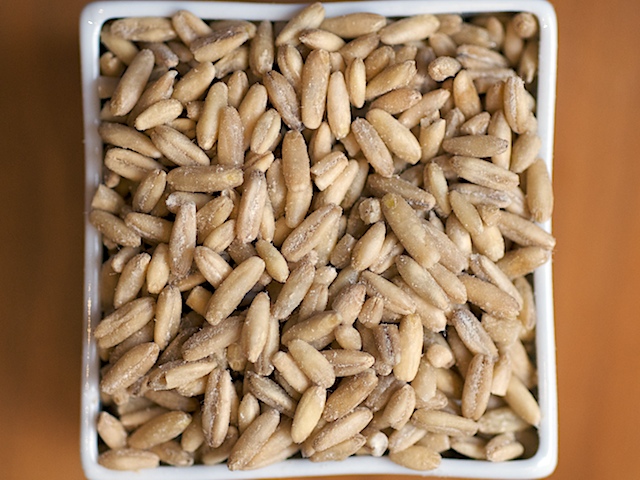
oat groats, l

polenta, l
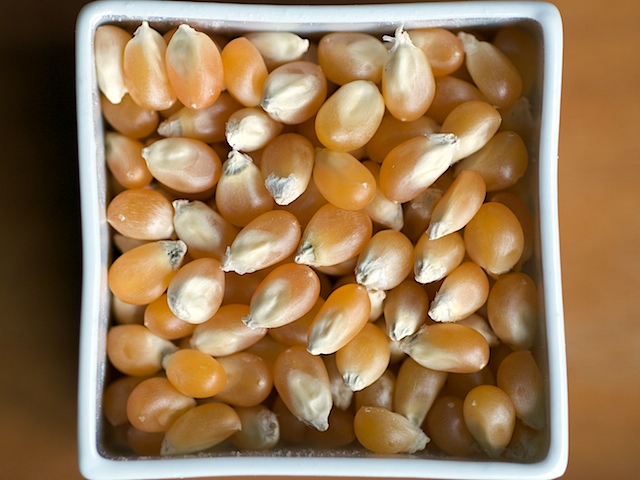
popcorn, l

quinoa, l
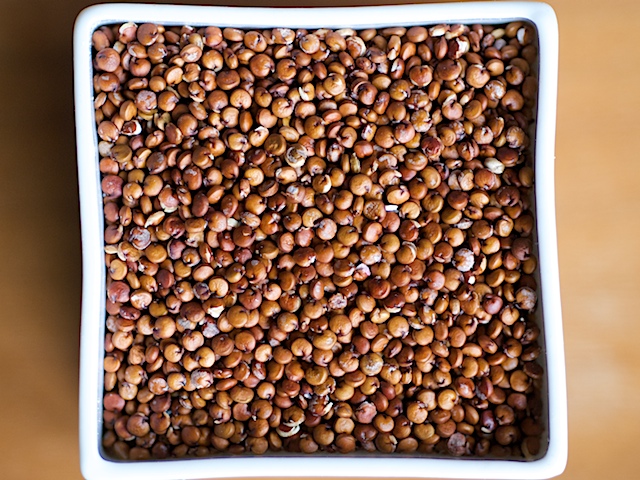
red quinoa, l
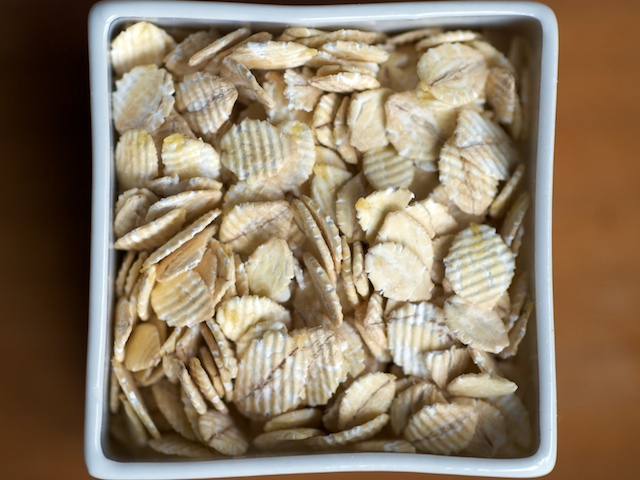
rolled barley, l
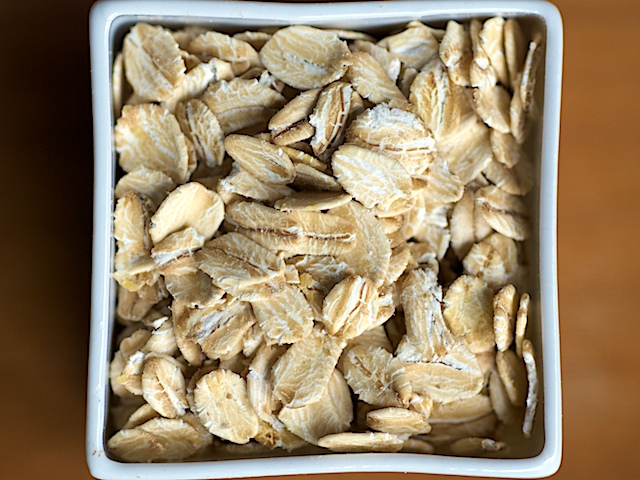
rolled oats, l
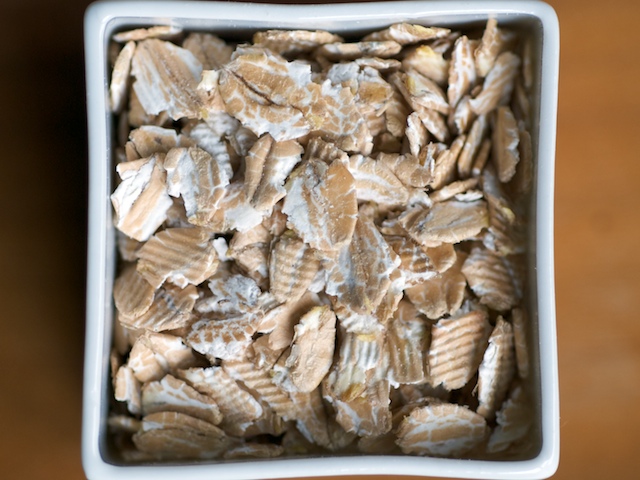
rolled triticale, l

short brown rice, l

sorghum, l

spelt berries, l

sweet brown rice, l
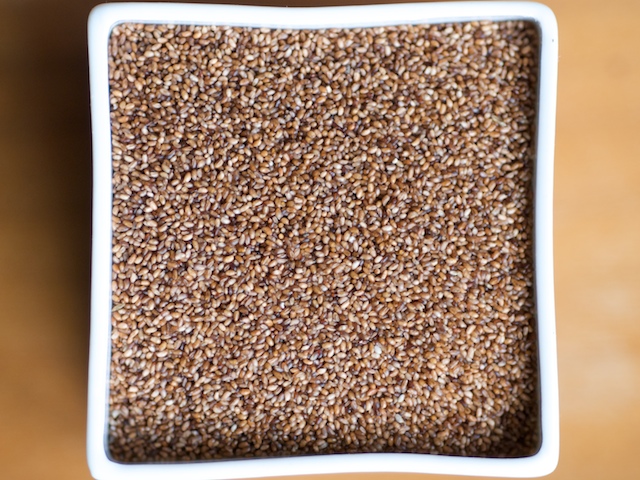
teff, l

wild rice, l

barley, l

reference-image, l
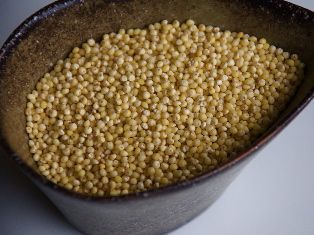
teardrop bowl, l

grains, l